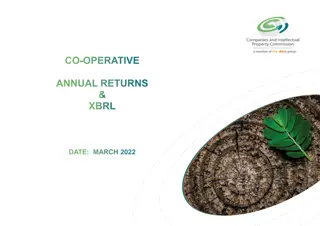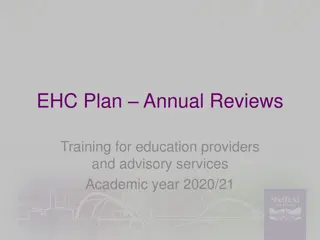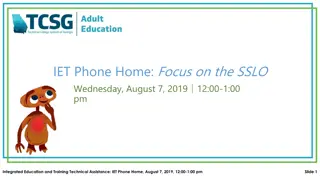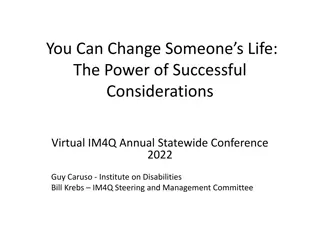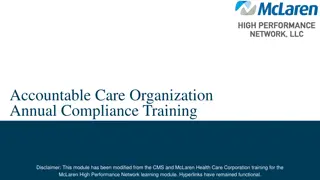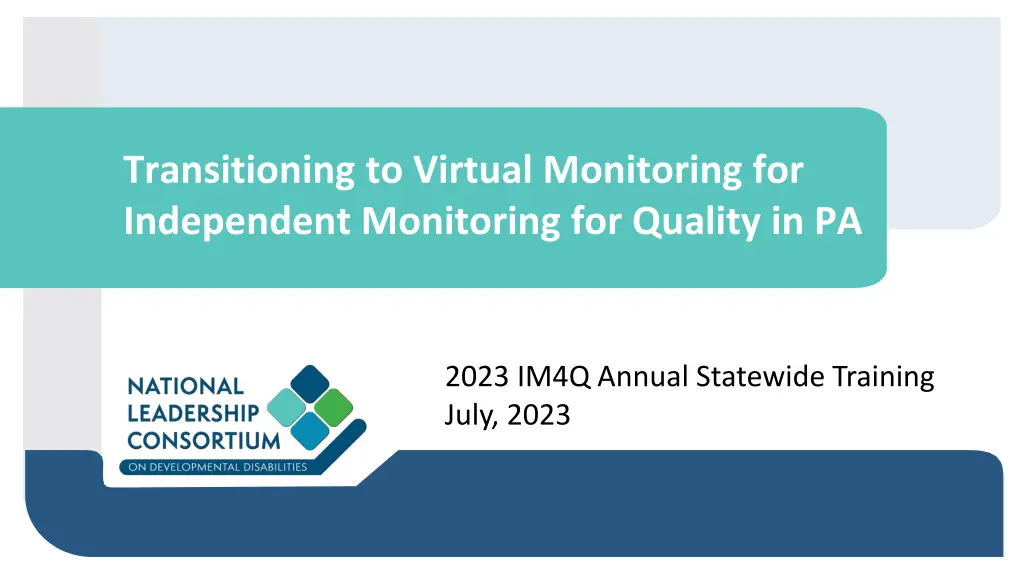
Transitioning to Virtual Monitoring: Quality in PA 2023 IM4Q Training
Explore the transition to virtual monitoring for independent quality monitoring in Pennsylvania in 2023. Gain insights from the National Leadership Consortium and an external evaluation on the effectiveness of virtual monitoring. Discover participant demographics, training feedback, confidence levels, and training recommendations for conducting virtual interviews.
Download Presentation

Please find below an Image/Link to download the presentation.
The content on the website is provided AS IS for your information and personal use only. It may not be sold, licensed, or shared on other websites without obtaining consent from the author. If you encounter any issues during the download, it is possible that the publisher has removed the file from their server.
You are allowed to download the files provided on this website for personal or commercial use, subject to the condition that they are used lawfully. All files are the property of their respective owners.
The content on the website is provided AS IS for your information and personal use only. It may not be sold, licensed, or shared on other websites without obtaining consent from the author.
E N D
Presentation Transcript
Transitioning to Virtual Monitoring for Independent Monitoring for Quality in PA 2023 IM4Q Annual Statewide Training July, 2023
The National Leadership Consortium Caitlin Bailey (She/Her), Co-Director National Leadership Consortium Cory Gilden (She/Her), Research & Evaluation Manager National Leadership Consortium
External Evaluation of Transition to Virtual Monitoring July 2022 Ongoing July-August 2022 Web-Based Survey Monitor Interviews Reporting 118 IM4Q Monitors and Program Coordinators Reporting of Results to IM4Q Staff and Other Audiences 12 Interviews with IM4Q Monitors with Disabilities
Participant Demographics 19.5% Program Coordinators 80.5% Monitors Has Disability 22.0% Has Family Member with Disability 28.8% No Disability or Family Member with Disability 29.6%
Training Hours of Training I Needed A Little More Training 12% I Needed A Lot More Training 1% Not At All Trained 4% 25 21.7% 21.7%21.7% 20 15 12% 10 7.2% 6% 4.8%3.6% Completely Trained 83% 5 1.2% 0 <1 Hour 1-2 Hours 2-3 Hours 3-4 Hours 4-5 Hours 6-7 Hours 7-8 Hours 9-10 Hours 10+ Hours
Confidence How confident did you feel conducting Zoom interviews? (N=94) Average Rating Before Training: 6.5 out of 10 60 53 Before Training 50 After Training 40 30 Average Rating After Training: 9.0 out of 10 26 20 17 13 13 12 12 10 6 5 5 5 5 5 3 3 2 1 1 1 0 0 0 0 0 1 2 3 4 5 6 7 8 9 10 Not at all confident Extremely Confident
attentive accessible enjoyable knowledgeable professional excellent thorough patient helpful supportive responsive hectic informative Very stressful
Training Recommendations Tools, Developing Rapport Virtually, Different Interview Formats (In-Person/ Online, Group/ Individual) Training For Monitor s Support Person Recorded Training, Cheat Sheets , Shadowing Opportunities Resources Role Play Scenarios Strategies, Troubleshooting Monthly Check Ins, Collaborate on Challenges and Successes Regular Meetings
Support Recommendations Headphones, Zoom Equipped iPads/ Tablets, Electronic Versions of Surveys Extra Equipment Check Ins and Guidance Environmental Adaptations for Virtual Interviews, Accompany monitors during interviews Space Office space to hold virtual interviews Coaching and Support For monitors without disabilities to support monitors with disabilities Troubleshooting Support Sending Zoom Links, Checking Webcams and Audio
Benefits to Virtual Monitoring More Convenient Requires Less Travel Easier to Schedule Safer More Engaging Enabled Monitors to Keep Working
Benefits to Virtual Monitoring It is difficult to travel to interviews. With [COVID- 19] it kept me safe not being around other individuals. I did not have to worry about accessibility of the houses. Monitor with a disability The Monitors could stay safe in their own homes and still participate in the IM4Q survey process, keeping them involved with this and still being able to make some money as well. Program Coordinator Monitor with a disability
Challenges to Virtual Monitoring Technical Issues No Access to Physical Surroundings Less Engagement No Privacy More No Shows
Challenges to Virtual Monitoring People are often more friendly in person, particularly parents and guardians. Parents and guardians are often wary of people asking questions of or about people with IDD. It s harder to build trust virtually than it is in person. Monitor without a disability I think in the beginning of [COVID-19] and virtual monitoring, individuals were really uncomfortable and didn't want to do anything online. With support, guidance, training, patience, and time, they became more confident and saw that they could do virtual and most enjoyed it. Program Coordinator
Quality of Virtual Monitoring Monitor Success in Gaining Information from Interviewees during Virtual Interviews (n=86) Monitor Success in Getting People Involved During Virtual Interviews (n=88)
Overall Experience Monitors with Disabilities: 8.9 Monitors Who Were Family Members: 8.5 Monitors without Disabilities: 8.6 Program Coordinators: 7.7
Overall Recommendations Personalized support and training Multi-formatted training and ongoing support Tangible training and reference materials Ongoing support and training Invite support staff to training
Comments? Questions? Cory Gilden cgilden@natleadership.org Caitlin Bailey cbailey@natleadership.org




